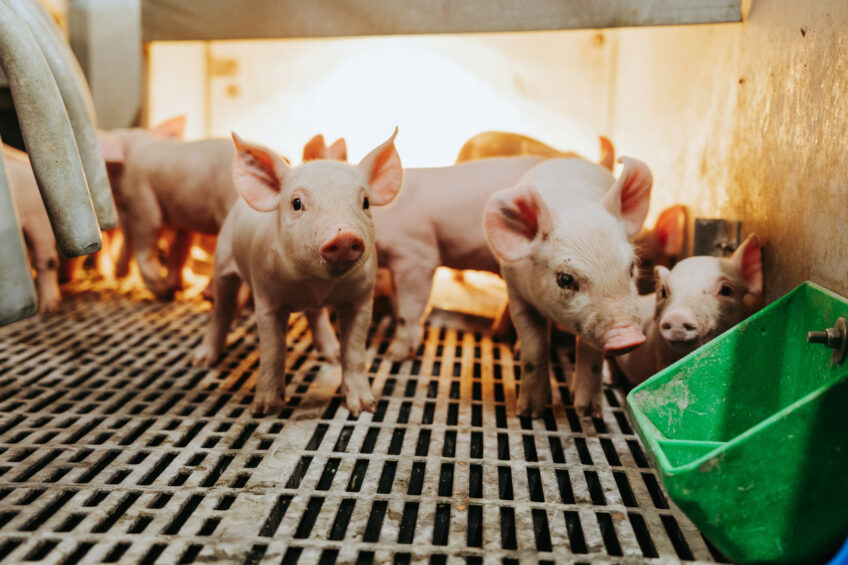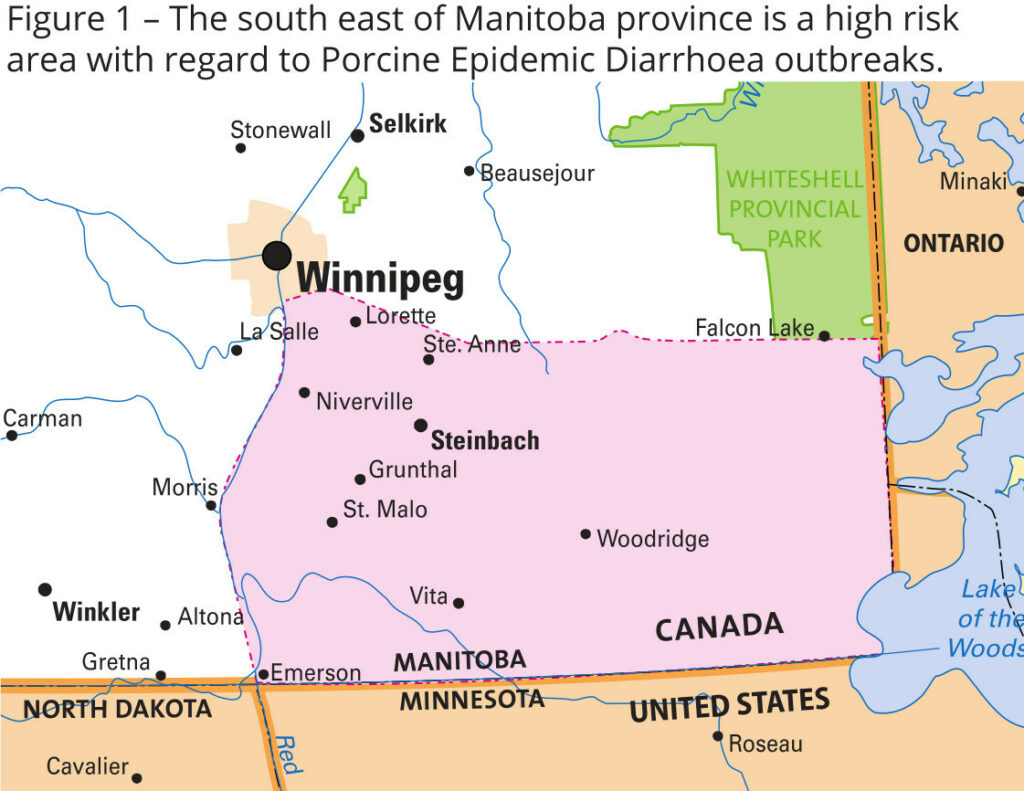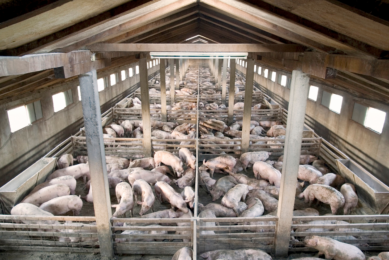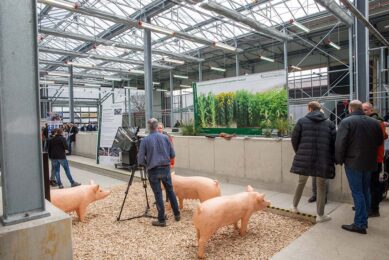The path towards PEDv elimination in Manitoba

Porcine Epidemic Diarrhoea virus (PEDv) has been troubling North America’s swine industry for over a decade. Waves come and go, but every time it gives a headache. Various US states and Canadian provinces are now planning for a long-term mitigation strategy. Manitoba, Canada is leading the way with an elimination plan.
Elimination has been the chosen strategy for the management of Porcine Epidemic Diarrhoea virus (PEDv) in Manitoba, since its first case in 2014. Regions of the province have since experienced significant PEDv outbreaks in 2017, 2019 and 2021-2022.
Beginning in 2022, the industry has been leading the development of a regional PEDv elimination plan for Manitoba. This 5-year plan outlines objectives and interventions to reach the sector’s elimination goal. Implemented in the fall of 2023, the elimination plan is a testament of commitment to action and collaboration amongst all parties within the sector.
Manitoba Pork – the provincial organisation representing commercial swine producers – along with Manitoba’s chief veterinary office have been working together and continue to do so to operationalise the plan and to navigate PEDv risk in the province, all with the ongoing guidance from sector stakeholders. This model of industry-government collaboration is unique. Regional disease control takes commitment from all stakeholders, and this plan serves as an example.
Planning for the future of PEDv
During the 2021-2022 outbreak, it became apparent that the PEDv management efforts needed reviewing. Dealing with a major PEDv outbreak every other year is not sustainable for the industry and an in-depth evaluation of PEDv management was necessary. Manitoba Pork convened a working group of industry stakeholders in early 2022 that included representation from producers, veterinarians, Manitoba’s Chief Veterinary Office and Manitoba Pork.
The mandate of the working group was to:
- outline both short- and long-term objectives for managing PEDv in Manitoba;
- assess possible strategies that could be employed to manage PEDv;
- determine the impacts of the strategies used in the high-risk area on other areas of Manitoba;
- provide outreach and messaging to the sector on PEDv management.
As a first step, the working group commissioned the University of Saskatchewan’s Western College of Veterinary Medicine to perform a review of available PEDv management strategies. Completed in April 2022, the review focused on PEDv strategies employed in different jurisdictions across North America with examples including elimination, gilt exposure, endemicity, use of vaccines and/or running positive flows. Based on this review, the working group decided that PEDv elimination remained the best option for Manitoba.

Development of a PEDv elimination plan
In 2022-2023, the working group collaborated with sector partners to develop an elimination framework titled “Manitoba’s PEDv Elimination Plan.” The plan outlines an overall goal with associated objectives and prevention/intervention actions to manage PEDv in Manitoba. Spanning 5 years (2022-2027), the plan is a living document that will be consistently reviewed to adjust strategies based on new experiences and learnings.
The goal is to eliminate 96% of PEDv infections in the high-risk area of South Eastern Manitoba by 2027, in a stepwise process by reducing the number of infections each year through prevention and intervention actions. These farm-level actions focus on surveillance, enhanced biosecurity and rapid and aggressive elimination protocols. The plan also outlines areas of future consideration where industry can focus risk-mitigation efforts, such as managing PEDv infected manure, risk from high traffic facilities and/or exploring the use of vaccines should an option become available.
In the fall of 2023, the working group members convened and endorsed the plan for implementation across the industry. Manitoba Pork shared the components of the plan broadly throughout its membership and sector stakeholders through targeted communications and presentations at numerous provincial producer meetings and industry seminars. Regular communication with the swine veterinarians in Manitoba was also integral to the understanding and implementation of the elements of the PEDv elimination plan on farm.
Implementation of the PEDv plan
Throughout 2024, many elements of the elimination plan saw meaningful progress. From prevention and enhanced biosecurity to disease modelling and communication, PEDv was top of mind for producers, veterinarians and industry stakeholders.
Based on previous experience, the next large-scale outbreak of PEDv was anticipated for 2024. With that in mind, a widespread prevention and preparedness campaign began in late 2023/early 2024. All stakeholders enhanced field-level biosecurity and communication efforts to actively prevent PEDv infection from taking hold in the high-risk area.
Biosecurity reviewed and enhanced
As part of the prevention elements of the plan, biosecurity practices were reviewed and enhanced. Hands-on training received specific focus, to ensure that what was communicated in a biosecurity protocol was well understood. Farms were and continue to be empowered to become their own biosecurity champions and call out potential breaches. Training and communication are people focused, which helps staff understand the why and the how behind biosecurity. The commitment to biosecurity from the farms, sector stakeholders and veterinarians is evident in the strides that have been made in 2024, with known PEDv risk still present in Manitoba.
Regular on-farm surveillance for PEDv across the high-risk area is an element of the elimination plan that continues to be explored. Farms are independently performing regular surveillance as a valuable early detection tool to limit the potential for downstream spreading. Expanding the on-farm surveillance plan will continue in 2025. Regular surveillance at high-traffic facilities such as assembly yards and abattoirs is also currently underway. This surveillance acts as an alert system and reinforces the risk of PEDv to the sector.
On-farm biosecurity software
Manitoba broadly implemented the use of on-farm biosecurity software. This software provides traceability for people, vehicles, equipment, etc., through geo-fencing technology. The communication component of the software can also broadly alert its farms of potential disease threats and limit access to farms. This has helped farms to react quickly to a possible disease event, implement biocontainment actions quickly and therefore reduce the risk of downstream spread.
As outlined in the plan, a 2024 objective was to develop a disease spread model for PEDv in Manitoba. The goal of the modelling work was to evaluate the actions and interventions outlined in the plan against the known disease transmission for PEDv in the province. Working with a veterinary epidemiology consultant, the Manitoba swine sector’s PEDv disease spread model was created.
The results of the model showed enhanced biosecurity both on-farm and during transport as the most effective action to be taken to minimise disease transmission. Applying multiple actions at once, such as enhanced biosecurity, reducing risk from high traffic facilities and limiting movements, did see a greater combined impact on reducing disease transmission. Overall, the results of this project did reinforce the actions outlined in the plan as key measures to take as Manitoba works towards PEDv elimination.
Communication remains an overarching objective of the PEDv elimination plan. All the efforts made to further the elements of the plan, such as in enhanced biosecurity, modelling and surveillance, has been strategically communicated to maintain momentum and awareness of the work that is being done and the rationale behind it.
Manitoba collaboration
The Manitoba approach to disease management has been one of collaboration. The key to success in a regional disease response is consistency, rapid response and information sharing amongst all parties. The Manitoba swine sector recognises the importance of regional management of PEDv and the need to work together to achieve the goal.
Information sharing was one of the first elements the sector led, even prior to the development of the PEDv elimination plan. The Manitoba Coordinated Disease Response (MCDR) was developed in 2017 by the Manitoba swine sector in response to the first major outbreak of PEDv. The MCDR is a password-protected online platform where producers can sign up to agree to share their PEDv health status with other producers who have also signed on. This confidentiality agreement between the producer, Manitoba Agriculture (the provincial ministry) and Manitoba Pork, allows for on-farm disease information as well as information on disease risk in the province to be shared.
The established working group is now taking the model for creating the PEDv plan and discussing how this approach can be applied to other disease issues in Manitoba. The sector sees value in this, not only for production diseases but also for planning and preparation activities related to potential foreign animal disease.
Looking to 2025
The Future of PEDv Working Group continues to meet to review progress and provide guidance on the implementation of the PEDv elimination plan. As immunity in the sow herds continues to decrease and the risk of PEDv to the sector remains, 2025 will be another test for the sector. Should PEDv cases arise, the plan will not be considered a failure, but a test of the approach that was developed. Maintaining the step-wise elimination approach coupled with the dedication to continuous learning and improvement will help the sector navigate through to 2027 and beyond.
This article is an approved edit from the proceedings of the 2025 annual meeting of the American Association of Swine Veterinarians (AASV), held in San Francisco, 1-4 March 2025.











